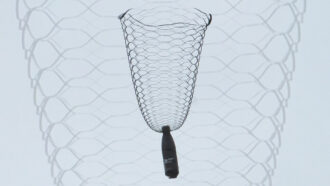Project music
From hard rock to country and classical, music comes into play in several award-winning science projects.
Share this:
- Share via email (Opens in new window) Email
- Click to share on Facebook (Opens in new window) Facebook
- Click to share on X (Opens in new window) X
- Click to share on Pinterest (Opens in new window) Pinterest
- Click to share on Reddit (Opens in new window) Reddit
- Share to Google Classroom (Opens in new window) Google Classroom
- Click to print (Opens in new window) Print
By Emily Sohn
Music can make or break a party. It can also improve your health, your driving, and your math and physics skills, according to some of the projects at this year’s Intel International Science and Engineering Fair (ISEF).
More than 1,400 high school students, selected from a pool of millions, came to Portland, Ore., in May to present their science projects and compete for $3 million in scholarship money and other prizes.
Music was the focus of several research projects at ISEF this year. That’s probably not surprising. Music is a popular form of entertainment, and young people pay a lot of attention to it. Rap, rock, folk, jazz, R&B, country, klezmer: Almost everyone has a favorite type.
Classical feel
Classical music is the genre of choice for Richie and Ryan Huynh, 15-year-old identical twins from Champlin, Minn. The freshmen perform with a couple of orchestras. Richie plays the viola. Ryan plays the violin.
It doesn’t matter whether they’re performing or listening to classical music, the twins say. Either way, it makes them feel good.
“It’s a great way to relax and escape,” Ryan says. “Sometimes, we play all night long.”
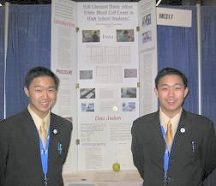 |
|
Richie and Ryan Huynh of Champlin, Minn., did a science project on the effect of listening to classical music on a person’s white blood cell count.
|
| E. Sohn |
Classical music makes them feel so good, in fact, that Richie and Ryan wondered if music calms more than just the mind. For their project, they studied how classical music affects the body.
For 6 weeks, 11 volunteers (all 14- and 15-year-olds) listened to classical music for 20 minutes every day. They were told not to do anything else at the same time. Another 10 volunteers carried on with their normal lives—with no classical music. Each week (except for a 1-week vacation break), the school nurse drew blood from all 21 students.
Richie and Ryan then took a drop from each blood sample and smeared it on a slide. On each slide, they counted white blood cells, which are responsible for fighting diseases and germs. The more white blood cells you have, the healthier you are. The counting involved hours of work every day after school.
The results showed that, over the course of the 6-week experiment, the white blood cell count went up and down in both groups. Consistently, however, the students who listened to classical music had higher counts than those who didn’t.
“We did some research and found that people with less stress have higher white blood cell counts,” Ryan says. “We think it has to do with relaxation.”
Just sit back and let Mozart stream in for a little while each day, the brothers say, for a healthier, less stressful life.
Tough rock
Hardcore punk rock or heavy metal probably would not produce the same kind of benefits, another ISEF project suggested. Aggressive music might even hurt you.
That’s what Rebecca Wilder, an 18-year-old senior from Mentor, Ohio, discovered. Her study showed that the kind of music you listen to while you drive could actually affect your chances of getting hurt in a car crash.
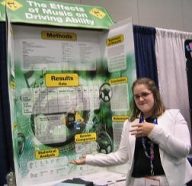 |
|
Rebecca Wilder of Mentor, Ohio, studied the effects of different types of music on driving ability.
|
| E. Sohn |
For her project, Rebecca brought 50 teenage volunteers to an arcade, one at a time. Each student played three rounds on a driving simulation game called “California Speed.” Each round lasted 3 minutes.
During one round, participants used headphones to listen to an aggressive rock song called “Y’all Wanna Single” by Korn. During another round, they listened to a weepy country song called “Don’t Take the Girl” by Tim McGraw. In a third round, they drove in silence. The order of rounds was random. Throughout the experiment, Rebecca counted crashes.
Her results showed that aggressive music might be the most dangerous. Players crashed an average of 10.7 times in 3 minutes while listening to the Korn song. They averaged 6.1 crashes during the sad country song and 8.4 crashes when there was no music.
In reports of other research, Rebecca found evidence that music affects emotion centers in the brain. She speculates that aggressive music makes people aggressive, whereas slow music relaxes them. Driving in silence might encourage people to space out and crash more, she says.
Car accidents killed 6,300 teens between the ages of 15 and 19 in 1998, Rebecca notes. She hopes that her research might inspire Intel, the sponsor of ISEF, to invent a chip that can block certain radio stations on car radios. Keeping young people from listening to the hard stuff when they’re on the road could save lives, she says.
Violin sounds
Saving lives was not on Linden Webster’s mind last summer. She was too busy playing the violin.
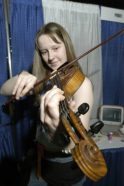 |
|
Linden Webster of Midlothian, Scotland, plays her violin as part of her physics project studying what factors affect a violin’s quality.
|
| Intel |
For 6 weeks, the 17-year-old from Midlothian, Scotland, recorded herself playing notes on four violins in a special, echo-less room called an anechoic chamber. She plugged the recordings into a computer program that turned the sound into graphs. Her goal was to figure out what makes one violin sound better than another violin.
“When I was given the opportunity to complete this project, I suddenly realized I knew nothing about how a violin makes sound,” says Linden, who has been playing since she was 8 years old. “I was embarrassed by how little I knew,” she says.
Linden’s work demonstrated how essential certain vibrations are. When a violin is played, it vibrates. Depending on the violin, vibrations at certain frequencies are much stronger than those at other frequencies. These special frequencies are known as resonances.
High-quality violins have resonances that occur at particular frequencies, Linden says, so they sound better.
Her insights might some day come in handy for violinmakers, Linden says. “Using physics can help us find the best way to make violins and to make them cheaper,” she says.
In the meantime, Linden has a better understanding of how her own violin works. “Now, when something goes wrong,” she says, “I’ll have a better idea why.”
Math beat
Studying music can do more than boost your physics and performance skills, another young violin player found. It can also make you better at math, says Ana Peterlin, a 13-year-old freshman from Fairbanks, Alaska.
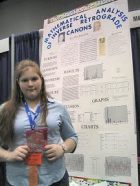 |
|
Ana Peterlin of Fairbanks, Alaska, holds a CD containing a musical piece that she composed and analyzed mathematically.
|
| E. Sohn |
Ana composed a retrograde inversion canon—a piece of music performed simultaneously by two people. One person plays from the first note to the last, while the other plays from the last note to the first, reading the music upside down. She named her composition “Upside Down and Right Side Up!”
Ana then compared her piece to one of Mozart’s retrograde inversion canons, called “Table Music for Two.” Both compositions have the same beat, the same key, and the same range of musical notes. But they differ considerably in the types of notes that are used. Ana’s piece, for example, has many more sixteenth notes.
In the process of analyzing the compositions, Ana discovered some unexpected mathematical patterns in Mozart’s piece. For one thing, he divided his piece into two sections, where one part is longer than the other. It turns out that the ratio of the length of one part to that of the other is a special number called the golden ratio.
Mozart himself was fascinated by numbers. As a kid when he was learning arithmetic, he once covered the walls of all the rooms in his house with figures. When Mozart was 14 and busy with music, he still found time to ask his sister to send him extra math exercises. The margins of one of Mozart’s musical compositions contain calculations of his chances of winning a lottery. He used math in a variety of ways to guide how he composed some of his musical pieces.
Ana was delighted to see her passion for music intersect with her passion for math. “Both help each other,” she says. “Music stimulates your brain, and you use math so much in music. You can’t have one without the other.”
Watch out, math teachers. Singing multiplication tables may be next!
Going Deeper:

